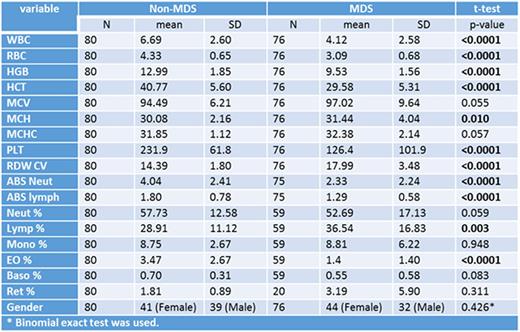Abstract
Introduction:
Myelodysplastic syndromes (MDS) are a heterogeneous group of clonal myeloid disorders, affecting primarily older individuals and characterized by abnormal hematopoiesis, varying degrees of bone marrow failure, and an increased risk for transformation to acute myeloid leukemia (AML). Despite recent technical advances in diagnostic hematology, accurate diagnosis and staging of MDS still relies heavily on morphologic assessment of peripheral blood and bone marrow cells, usually by an experienced hematopathologist. Peripheral cytopenias and the presence of dysplastic changes are required in all cases, to consider a diagnosis of MDS. However, the initial assessment of dysplasia in peripheral blood cells by manual differential can often be subjective. Furthermore, important components of the CBC generated by modern analyzers and relevant to the morphologic properties of blood cells, are often overlooked. These factors may contribute to why the true incidence of MDS is under-estimated. We undertook a retrospective case-control study to evaluate MDS relevant parameters generated by automated cell counters at our institution, to fully exploit the potential for modern analyzers to assist in the diagnosis of MDS, and to assist in the diagnostic yield for these important and usually fatal diseases.
Methods:
We identified patients with MDS who had peripheral blood counts reported by theSysmexXN-3000 automated analyzer over a one year period (from 6/2015 to 6/2016). The modern Sysmex cell counter generates several parameters directly relevant to the morphologic properties of blood cells including standard deviation of red cell distribution width (RDW-SD), mean platelet volume (MPV), immature platelet fraction (IPF), reticulocyte hemoglobin (RET-HE), immature granulocytes (IG) and immature reticulocyte fraction (IRF). A control group was selected consisting of patients with normal blood counts reported by the same analyzer and generated during the study period. The study and control groups were matched in age, gender and ethnicity to reduce bias. All parameters generated by automated hematology testing were statistically compared between the two groups and significant differences were used to develop a predictive model. Statistical analysis was largely descriptive for patient demographics (age, gender, and race/ethnicity) and complete blood count (CBC) parameters. Counts and percentages were used to summarize the distribution of categorical variables and median, range, mean, and standard deviation were used for continuous variables. CBC parameters were compared by treatment group (MDS vs. Control) using two sample tests (t-test or binomial exact test).
Results:
Of a sample size of over 200 patients during the study period, there were 80 evaluable patients for this interim analysis and results are presented in tabulated form (see table below). In our sample, we confirmed what has been previously reported in the literature, as statistically significant parameters in correctly predicting an MDS diagnosis (iereduced hemoglobin [Hgb, p<0.0001], hematocrit [Hct, p<0.0001] , white cell [WBC, p<0.0001] and platelet counts [Plts, p<0.0001]; increased mean corpuscular volume [MCV, p<0.001], mean corpuscular hemoglobin [MCH, p<0.0001] and red cell distribution width [RDW p<0.0001]. In addition to these parameters, we also found that decreased red blood cell counts (RBC, p<0.0001), neutrophils (ANC, p<0.0001) and lymphocytes (ANL, p<0.0001) were important predictive abnormalities. The performance of a predictive model incorporating the parameters listed in addition to RDW-SD, MPV, IPF, RET-HE, IG and IRF will be presented.
Conclusion:
Maximizing the utility of new and improved automated hematology analyzer technologies for early detection of MDS will greatly benefit both clinicians and patients by facilitating earlier diagnosis of MDS, eliminating subjectivity in the initial assessment of dysplasia and promoting better use of results from minimally invasive peripheral blood collection.
Statistical correlation between CBC parameters and their diagnostic utility in correcting predicting patients with MDS
Statistical correlation between CBC parameters and their diagnostic utility in correcting predicting patients with MDS
No relevant conflicts of interest to declare.
Author notes
Asterisk with author names denotes non-ASH members.


This feature is available to Subscribers Only
Sign In or Create an Account Close Modal